Speech The Next Chapter
I would like to thank the American Chamber of Commerce in Australia for the invitation to speak today. It is a pleasure to be in Perth again.
This lunch is being held at a time when one chapter in Australia's economic history is drawing to a close and another is about to start. A main theme in the chapter that is about to come to an end is the mining investment boom. That boom, and its unwinding, has been central to the story of the Australian and Western Australian economies for more than a decade now. The new chapter will, almost certainly, have a different central theme.
Today, I would like to provide a sketch of some of the likely plot lines of the next chapter. Before doing that, though, I will reflect on the current chapter.
The Current Chapter
The storyline of the current chapter is well known. It has had two main plot lines.
The first was a troubled global economy. A decade ago we had the global financial crisis and the worst recession in many advanced economies since the 1930s. A gradual recovery then took place, but it was painfully slow. Recently, things have improved noticeably and unemployment rates in some advanced economies are now at the lowest levels in many decades. Throughout this chapter, central banks have mostly worried that inflation rates might turn out to be too low, not too high. Interest rates have been at record lows. And workers in advanced economies have experienced low growth in their nominal wages. So it's been a challenging international backdrop.
The second plot line was the resources boom. Strong growth in China saw strong growth in demand for resources. Prices rose in response, with Australia's terms of trade reaching the highest level in at least 150 years (Graph 1). Then an investment boom took place in response to the higher prices, with investment in the resources sector reaching its highest level as a share of GDP in over a century. And now we are seeing the dividends of this, with large increases in Australia's resource exports.
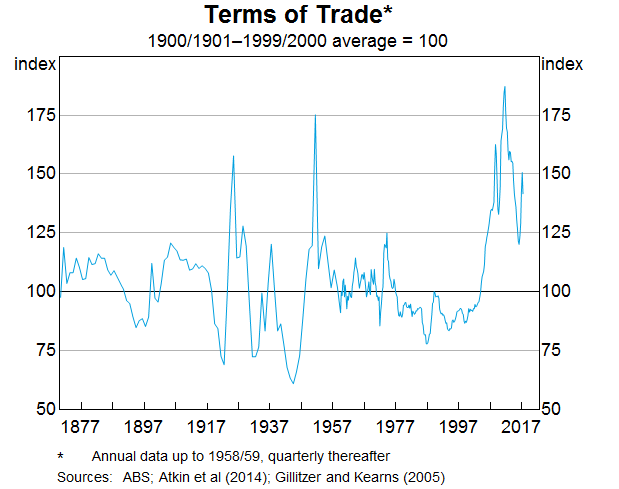
Overall, it has been a reasonably successful chapter in Australia's economic history. Real income per person is around 20 per cent higher than it was in the mid 2000s and real wealth per person is 40 per cent higher. Australia is one of the few advanced economies that avoided a recession in 2008. And the biggest mining boom in a century did not end in a crash, as previous booms did. Our interest rates remained positive, unlike those in many other advanced economies. Since the mid 2000s, the unemployment rate has averaged 5¼ per cent, a better outcome than in the previous three decades. Inflation has averaged 2½ per cent. And over this period, GDP growth has averaged 2¾ per cent, higher than in most other advanced economies.
So, taking the period as a whole, it is a positive picture.
At the same time, though, as the chapter draws to a close, we do face some issues. I would like to highlight three of these.
The first is the recent slow growth in real per capita income. For much of the past two decades, real national income per person grew very strongly in Australia (Graph 2). We benefited from strong productivity growth, higher commodity prices and more of the population working. In contrast, since 2011 there has been little net growth in real per capita incomes. This change in trend is proving to be a difficult adjustment. The solutions are strong productivity growth and increased labour force participation.
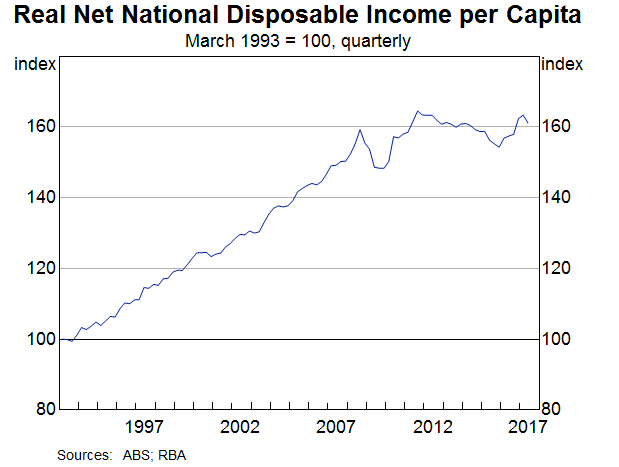
A second issue is the unusually slow growth in nominal and real wages. Over the past four years, the increase in average hourly earnings has been the slowest since at least the mid 1960s (Graph 3). This is partly a consequence of the unwinding of the mining boom but there are structural factors at work as well. The slow growth in wages is putting a strain on household budgets and contributing to low rates of inflation.
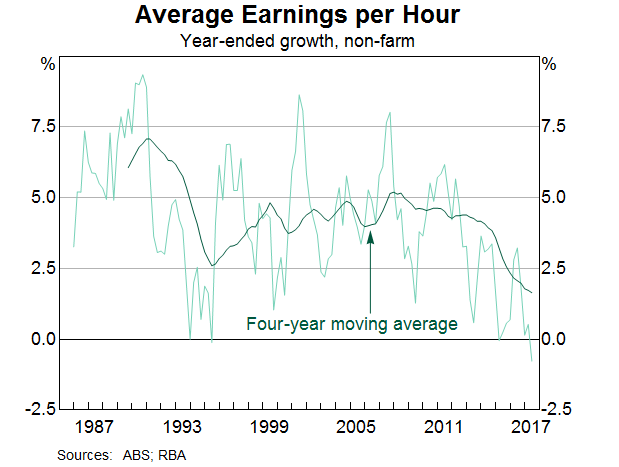
A third issue is the high level of household debt and housing prices. Over recent times, Australians have borrowed a lot to purchase housing. This has added to the upward pressure on housing prices, especially in our two largest cities, where structural factors are also at work. Australians are coping well with the higher level of debt, but as debt levels have increased relative to our incomes so too have the medium-term risks. The very high levels of housing prices in our largest cities are also making it difficult for those on low and middle incomes to buy their own home.
So as we turn the final pages of this chapter, these are some of the issues we face. But as we turn these pages, we also see improvements on a number of fronts.
Business conditions, as reported in surveys, are at the highest level in almost 10 years. There are also growing signs that private investment outside the resources sector is picking up. We have been waiting for this for some time. For a number of years, animal spirits had been missing, with many firms preferring to put off making decisions about capital spending. It appears that some of this reluctance to invest is now passing. According to the June quarter national accounts, private non-mining business investment increased strongly over the first half 2017, to be around 10 per cent above the level at the start of 2016. Non-residential building approvals have increased to be above the levels of recent years and there is a large pipeline of public infrastructure investment to be completed (Graph 4). The decline in mining investment has also largely run its course.
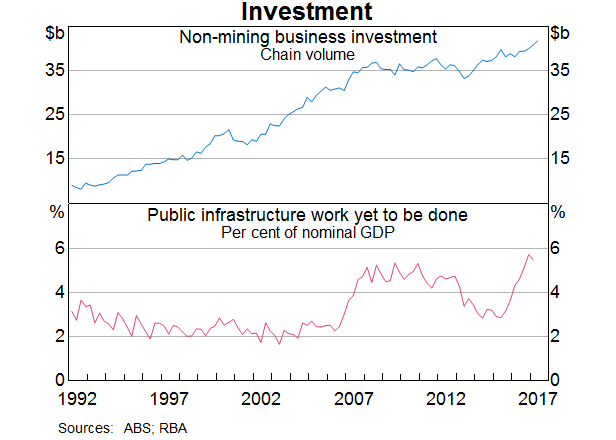
There has also been positive news on the employment front. Over the past year, the number of people with jobs has increased by more than 2½ per cent, a positive outcome given that the working-age population is increasing at around 1½ per cent a year. Growth in full time employment has been particularly strong. The various forward-looking indicators suggest that labour market conditions will remain positive in the period immediately ahead.
Here in Western Australia, there are also some signs of improvement after what has been a difficult few years. The drag from declining mining investment is diminishing. Businesses are feeling more positive than they were a year ago and employment has been rising after a period of decline. At the same time though, conditions in the housing market remain difficult, with housing prices and rents continuing to fall in Perth. Weak residential construction has also weighed on aggregate demand over the first half of this year, although building approvals and liaison reports point to some stabilisation in the period ahead (Graph 5).
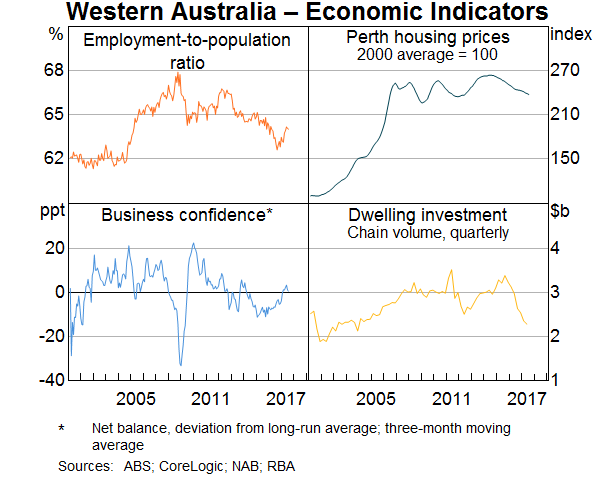
For Australia as a whole, the recent national accounts – which showed a healthy increase in output of 0.8 per cent in the June quarter – were in line with the Bank's expectations. These, and other recent data, are consistent with the Reserve Bank's central scenario for GDP growth averaging around the 3 per cent mark over the next couple of years. This is a bit faster than our current estimate of trend growth in the Australian economy, so we expect to see a gradual decline in the unemployment rate. This should lead to some pick-up in wage growth, although we expect this to be a gradual process given the structural factors at work that I have spoken about on previous occasions. We can also expect to see a gradual increase in inflation back towards the middle of the 2 to 3 per cent medium-term target range.
There are clearly risks around this central scenario. We would like to see the improvement in business investment consolidate and a continuation of job growth at a rate at least sufficient to absorb the increase in Australia's workforce. Some pick-up in wage growth in response to the tighter labour market would also be a welcome development. So these are some areas to watch. But as things stand, the economy does look to be improving.
The Next Chapter
I would now like to lift my gaze a little and turn to the next chapter in our economic story. I would like to sketch out four of the possible plot lines, acknowledging that, as in all good stories, there are likely to be plenty of surprises along the way.
Shifts in the global economy
A first likely plot line, as it has been in previous chapters, is the ongoing shift in the global economy. Here, changes in technology and further growth in Asia are likely to be prominent themes.
In some quarters there is pessimism about future prospects for the global economy. The pessimists cite demographic trends, high debt levels, increasing regulatory burdens that stifle innovation and political issues. They see a future of low productivity growth and only modest increases in average living standards.
It's right to be concerned about the issues that the pessimists focus on, but I am more optimistic about the ability of technological progress to propel growth in the global economy, just as it has done in the past. We are still learning how to take advantage of recent advances in technology, including the advances in the tools of science. In time we will do this and new industries and methods of production will evolve, some of which are hard to even imagine today. So there is still plenty of upside. The challenge we face is to make sure that the benefits of technological progress are widely shared. How well we do this could have a major bearing on the next chapter.
Beyond this broad theme, it is appropriate to recognise the important leadership role that the United States plays in the global economy. If the US economy does well, so does most of the rest of the world. The United States has long been a strong supporter of open markets and a rules-based international system. It has been the breeding ground for much of the progress in technology. And it has been a safe place for people to invest and an important source of financial capital for other countries. It is in our interests that the United States continues to play this important role. A retreat would make our lives more complicated.
Another important influence on the next chapter is how things play out in China. While growth in China is trending lower, the share of global output produced in China will continue to rise, as per capita incomes converge towards those in the more advanced economies (Graph 6). As this convergence takes place, the structure of the Chinese economy will change and so too will China's economic relationship with Australia. Exports of resources will continue to be an important part of that relationship, but increasingly trade in services and other high value-added activities, including food, will become more important. Notwithstanding this, there are risks on the horizon, with the Chinese economy going through some difficult adjustments. One of these is the switch from a growth model based on industrial expansion to one based more on services. Another is managing an increasingly large and complex financial system. Australia has a strong interest in China successfully managing these challenges.
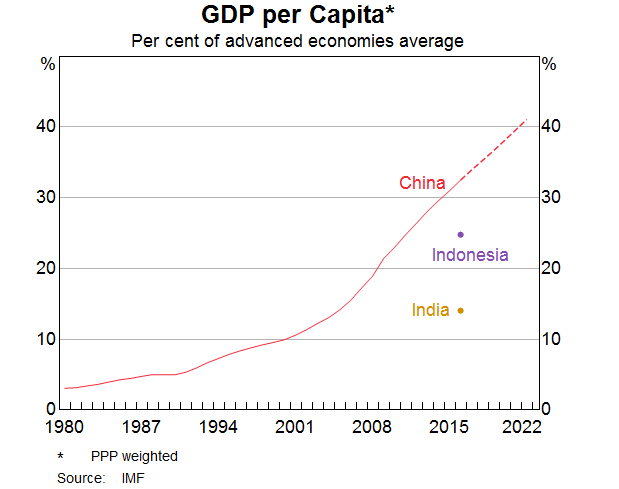
Another shift in the global economy that could shape the next chapter is the growth of other economies in Asia. Developments in India and Indonesia bear especially close watching. Both of these countries, especially India, have very large populations, and per capita incomes are still quite low. In time, the effects of economic progress in these countries and others in the region could be expected to have a substantial effect on the Australian economy, just as the development of China has.
Normalisation of monetary conditions
A second likely plot line of the next chapter is a return to more normal monetary conditions globally. Since the financial crisis we have been through an extraordinary period in monetary history. Interest rates have been very low and even negative in some countries. Central banks have greatly expanded their balance sheets in order to buy assets from the private sector (Graph 7). This period of monetary expansion is now drawing to a close.
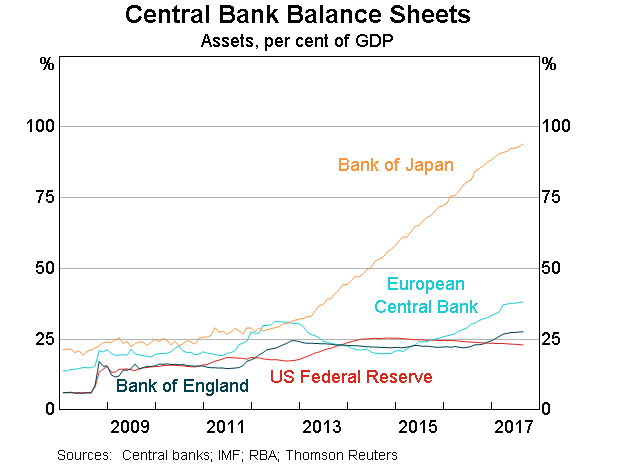
Some normalisation of monetary conditions globally should be seen as a positive development, although it does carry risks. It is a sign that economic growth in the advanced economies has become self-sustaining, rather than just being dependent on monetary stimulus. It would also lift the return to many savers who have been receiving very low returns on interest-bearing assets for a decade now.
On the other side of the ledger, periods of rising interest rates globally have, historically, exposed over-borrowing somewhere in the global system. Investment strategies that looked sensible when interest rates were very low tend not to look so good when interest rates are higher.
We can take some comfort from the major efforts over the past decade to improve the resilience of the global financial system. But at the same time, investors have increasingly been prepared to take more risk in the search for yield. Many continue to expect a continuation of low rates of inflation and low interest rates, despite quite low unemployment rates in a number of countries. So this is an area that is worth watching. If higher interest rates are the result of a surprise increase in inflation, financial markets could be in for a difficult adjustment.
A rise in global interest rates has no automatic implications for us here in Australia. Notwithstanding this, an increase in global interest rates would, over time, be expected to flow through to us, just as the lower interest rates have. Our flexible exchange rate though gives us considerable independence regarding the timing as to when this might happen.
Higher levels of debt
This brings me to a third plot line: that is, how we deal with the higher level of household debt and higher housing prices, especially in a world of more normal interest rates.
It is likely that higher levels of household debt change household spending patterns. Having increased their borrowing, households are less inclined to let consumption growth run ahead of growth in incomes for too long. Higher levels of debt also mean that household spending could be quite sensitive to increases in interest rates, something the Reserve Bank will be paying close attention to.
To date, households have been coping reasonably well with the higher debt levels. The aggregate debt-to-income ratio has trended higher, but the ratio of interest payments to income is not particularly high, given the low level of interest rates (Graph 8). Housing loan arrears remain low, although they have increased a little recently, especially here in Western Australia.
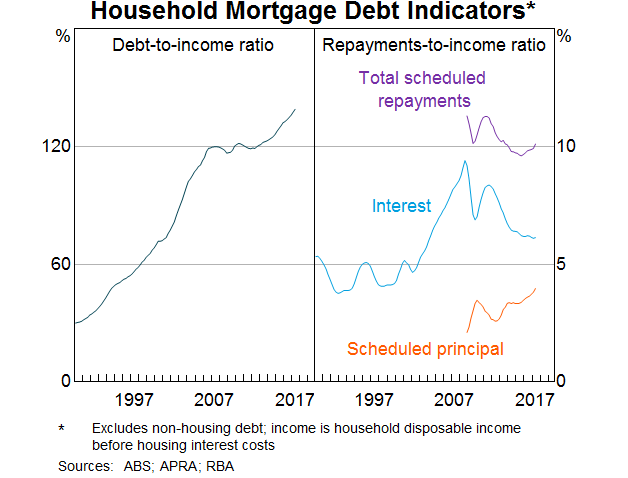
Over recent times, one issue that the Reserve Bank has focused on is the build-up of medium-term risks from growth in household debt persistently outpacing that in household income. Our concern has been that, in this environment, a small shock could turn into a more serious correction as households seek to repair their balance sheets. We have been working with APRA through the Council of Financial Regulators to address this risk. The various measures are having a positive impact in improving the resilience of household balance sheets.
A broadening of the drivers of growth
The fourth likely plot line is a broadening of the drivers of growth in the Australian economy. How the next chapter in our economic history turns out depends partly on our ability to lift productivity growth across a wide range of industries. The resources sector will, no doubt, continue to make an important contribution to the Australian economy, but it is unlikely that it will shape the next chapter in our economic history as it did the current chapter. With another major upswing in the terms of trade unlikely and the working-age share of our population having peaked as the population ages, improving productivity will be key to growth in our national income.
The drivers of growth are changing: they increasingly depend on our ability to produce innovative goods and services in a rapidly changing world. In this world, it is difficult to make precise predictions about where the jobs and growth in our economy are going to come from in the future. But it seems clear that we will be best placed to take advantage of whatever possibilities arise if businesses and our workforce are innovative and adaptable.
Australia is fortunate to have a natural resource base that provides an important source of national income, and this will remain the case. But in this next chapter we will need to look more directly to the skills of our workers and our businesses to drive economic growth. If we are to take advantage of the opportunities that are offered by technology and growth in Asia, we need a flexible workforce with strong skills in the areas of problem solving, critical thinking and communication. Investment in human capital will be one of the keys to success. We also need a competitive business environment that encourages innovation. How well the next chapter turns out will depend on how we do in these areas.
So, in summary these are some of the themes we might expect to see in the next chapter – the impact of technology and the growth of Asia; the normalisation of monetary conditions; the effects of higher levels of household debt; and the capability of our workforce and businesses to be flexible, innovative and adaptable.
This is, obviously, not a complete list. There are clearly other factors that could have a major influence on the storyline, including how geopolitical tensions are resolved and how we adjust to climate change. And no doubt there will be surprises as well.
But overall, I remain optimistic about how this next chapter might unfold. While we have our challenges, some of which I have talked about, we also have some advantages. We have a strong institutional and policy framework, a skilled, growing and diverse population and a wealth of mineral and agricultural resources. We have strong links to Asia, the fastest growing part of the global economy. We also have a flexible economy with a demonstrated capacity to adjust to a changing world.
These factors should give us confidence about our future. But we can't rest on this and there are a number of significant risks. The world is a competitive place and the global economy is continuing to go through some challenging adjustments. If we are to do well in this world, we need to keep investing in both physical and human capital. We also need to keep investing in policy reform.
Finally, I have said relatively little about monetary policy today. This is partly because there are other forces that are likely to be more important in shaping the next chapter of the Australian economy. Monetary policy has an important role to play in supporting the economy as it goes through the current period of adjustment. It can also help stabilise the economy when it is hit by future shocks. Monetary policy can make for a more predictable investment climate by keeping inflation low and stable. Having a competent, analytical, transparent and independent central bank can also be a source of confidence in the country. But beyond these effects, monetary policy has little influence on the economy's potential growth rate.
Over recent times, the Reserve Bank Board has not sought to overly fine-tune things. We have provided support and allowed time for the economy to adjust to the new circumstances. In its decisions, the Board has been careful to balance the benefit of providing this support with the risks that can come from rising household debt. As things currently stand, we look to be on course to make further progress in reducing unemployment and moving towards the midpoint of the medium-term inflation target. This would be a good outcome.
Thank you for listening and I look forward to answering your questions.
Endnotes
I would like to thank Andrea Brischetto for assistance in the preparation of this talk. [*]
